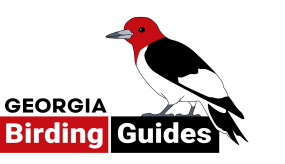FAQ
ANSWERS TO your QUESTIONS
Planning a birding trip involves many factors and some unknowns. This guide to frequently asked questions will assist you in the process. If you need further clarification on any points or have questions not covered here, please don’t hesitate to ask us!
Where do I go?
Georgia is a large state with a wide variety of habitats across its regions. Each area supports its own suite of specialty birds, often including species that are difficult to find elsewhere in the state. Visit our Locations page to explore which regions are home to which species. As you plan, consider your birding goals, how far you’re willing to travel, and your budget. If the sky’s the limit, consider a tour that starts in the Appalachians, continues south through the pineywoods, and finishes along the coast.


When do I come?
Georgia offers excellent birding year-round, though each season brings its own highlights. With habitats ranging from the Atlantic Ocean and coastal plain to the piedmont and the southernmost reaches of the Appalachian Mountains, different regions shine at different times of year. Coastal Georgia is at its best in the cooler months, when winter migrants fill the saltmarshes and nearshore waters. The mountains and bottomland forests are ideal in spring and summer, when resident birds are breeding and migrants have returned. Many of the pinewoods specialties are year-round residents and can be found in any season.
What will I see?
This depends on when you come, where you go, and your objectives. The Georgia Ornithological Society produces a useful up-to-date state checklist while eBird is without a doubt the most dynamic tool. Use the downloadable lists to determine which species you can expect to see or target during your visit. You can view species sorted by taxonomic order (evolutionary relationships) or sighting frequency (percentage of checklists that have reported the species). NOTE: frequency does not necessarily reflect the likelihood of seeing a given species.
TAXONOMIC Order
Sighting FREQUency
What do I bring?
Start with whatever you bring out birding on a regular basis – binoculars, spotting scope, camera, appropriate outerwear (including sunscreen, bug spray, and chapstick), daypack, and water/snacks. Check out our services page for a list of what we’ll bring along as well. Bring at least one layer each of clothes for warm, cold, and wet conditions. We recommend sticking with long pants, long sleeves, and closed-toed shoes when in the field.


What do I eat?
Food is handled based on circumstances and preferences. Breakfast is usually quick—either at your lodging, a fast restaurant, or packed ahead of time for the field. Lunch is often on the go as well, either packed or picked up from a quick stop along the way. Dinner is the best time to relax and savor a good meal out. Georgia is known for its soul food and Southern cuisine, like fried chicken and shrimp and grits. In Atlanta, you can find just about any type of cuisine from around the world. For beverages, you can’t go wrong with any of the state’s many local breweries. Yelp and TripAdvisor are excellent resources for discovering Georgia’s culinary highlights beyond just the birding spots!yelp
What is the weather like?
Georgia has a moderate climate with four seasons. Winters are mild but can get chilly in the mountains, while summers are hot and humid—great for the beach but often accompanied by afternoon thunderstorms. Spring brings rain and high pollen levels. The northern mountains are cooler and wetter than the warmer, humid coastal areas, where hurricane season runs from June to November. Since weather can change quickly, check forecasts on AccuWeather or Weather Underground before you go.


